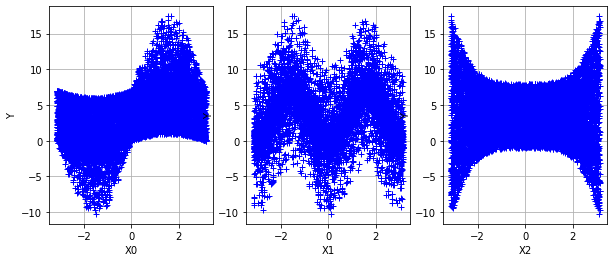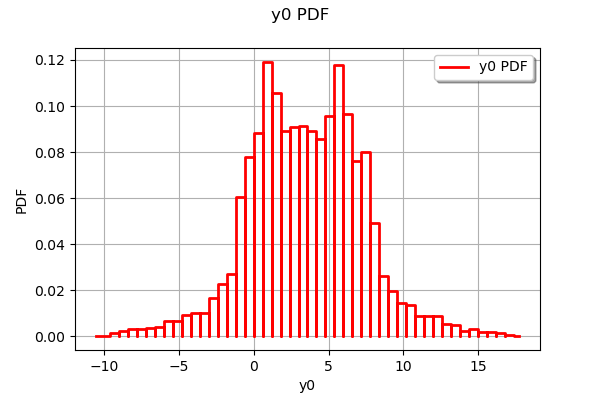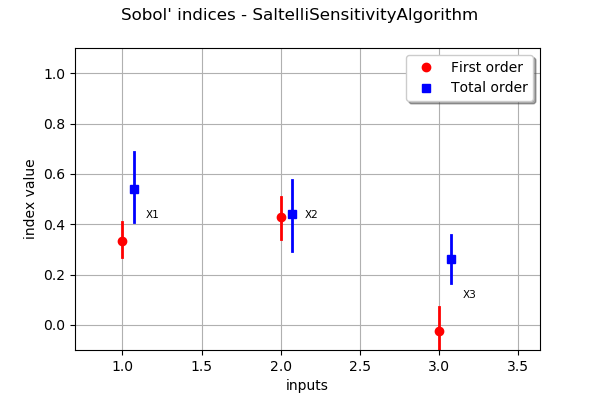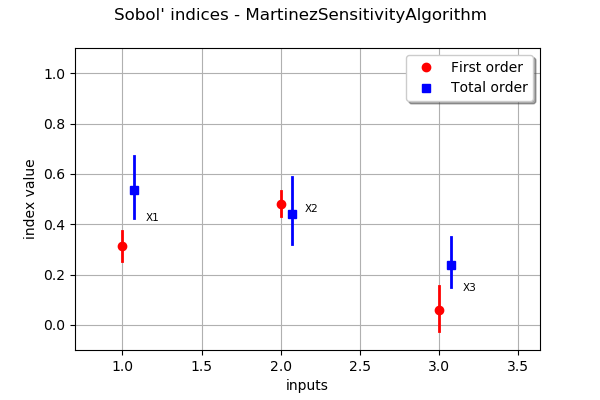Estimate Sobol’ indices for the Ishigami function by a sampling method: a quick start guide to sensitivity analysis¶
In this example, we estimate the Sobol’ indices for the Ishigami function by sampling methods.
Let and
. We consider the function
for any
We assume that the random variables are independent and identically distributed according to the uniform distribution on the interval
:
Introduction¶
In this example we are going to quantify the correlation between the input variables and the output variable of a model thanks to Sobol indices.
Sobol indices are designed to evaluate the importance of a single variable or a specific set of variables. Here the Sobol indices are estimated by sampling from the distributions of the input variables and propagating uncertainty through a function.
In theory, Sobol indices range from 0 to 1; the closer an index value is to 1, the better the associated input variable explains the function output.
Let us denote by the input dimension of the model.
Sobol’ indices can be computed at different orders.
First order indices evaluate the importance of one input variable at a time.
Total indices give the relative importance of one input variable and all its interactions with other variables. Alternatively, they can be viewed as measuring how much wriggle room remains to the output when all but one input variables are fixed.
In general, we are only interested in first order and total Sobol’ indices. There are situations, however, where we want to estimate interactions. Second order indices evaluate the importance of every pair of input variables. The number of second order indices is:
In practice, when the number of input variables is not small (say, when ), then the number of second order indices is too large to be easily analyzed. In these situations, we limit the analysis to the first order and total Sobol’ indices.
Define the model¶
[1]:
import openturns as ot
import numpy as np
import pylab as pl
import openturns.viewer
Create the Ishigami test function.
[2]:
ot.RandomGenerator.SetSeed(0)
formula = ['sin(X1) + 7. * sin(X2)^2 + 0.1 * X3^4 * sin(X1)']
input_names = ['X1', 'X2', 'X3']
g = ot.SymbolicFunction(input_names, formula)
Create the probabilistic model
[3]:
inputDimension = 3
distributionList = [ot.Uniform(-np.pi, np.pi)] * inputDimension
distribution = ot.ComposedDistribution(distributionList)
Draw the function¶
[4]:
n = 10000
sampleX = distribution.getSample(n)
sampleY = g(sampleX)
[5]:
def plotXvsY(sampleX, sampleY, figsize=(15,3)):
dimX = sampleX.getDimension()
inputdescr = sampleX.getDescription()
fig = pl.figure(figsize=figsize)
for i in range(dimX):
ax = fig.add_subplot(1, dimX, i+1)
graph = ot.Graph('', inputdescr[i], 'Y', True, '')
cloud = ot.Cloud(sampleX[:,i],sampleY)
graph.add(cloud)
_ = ot.viewer.View(graph, figure=fig, axes=[ax])
return fig
plotXvsY(sampleX, sampleY, figsize=(10,4));

[6]:
ot.HistogramFactory().build(sampleY).drawPDF()
[6]:

We see that the distribution of the output has two modes.
Estimate the Sobol’ indices¶
We first create a design of experiments with the SobolIndicesExperiment. Since we are not interested in second order indices for the moment, we use the default value of the third argument (we will come back to this topic later).
[7]:
size = 1000
sie = ot.SobolIndicesExperiment(distribution, size)
inputDesign = sie.generate()
inputDesign.setDescription(input_names)
inputDesign.getSize()
[7]:
5000
We see that 5000 function evaluations are required to estimate the first order and total Sobol’ indices.
Then we evaluate the outputs corresponding to this design of experiments.
[8]:
outputDesign = g(inputDesign)
Then we estimate the Sobol’ indices with the SaltelliSensitivityAlgorithm.
[9]:
sensitivityAnalysis = ot.SaltelliSensitivityAlgorithm(inputDesign, outputDesign, size)
The getFirstOrderIndices and getTotalOrderIndices method respectively return estimates of all first order and total Sobol’ indices.
[10]:
sensitivityAnalysis.getFirstOrderIndices()
[10]:
[0.334197,0.42868,-0.0246479]
[11]:
sensitivityAnalysis.getTotalOrderIndices()
[11]:
[0.538721,0.440278,0.2622]
The draw method produces the following graph. The vertical bars represent the 95% confidence intervals of the estimates.
[12]:
graph = sensitivityAnalysis.draw()
graph
[12]:

We see that the variable
, with a total Sobol’ index close to 0.6, is the most significant variable, taking into account both its direct effect and its interactions with other variables. Its first order index is close to 0.3, which implies that its interactions alone produce almost 30% (0.6 - 0.3) of the total variance.
The variable
has the highest first order index: approximately 0.4. However, it has little interaction with other variables since its total order indice is close to its first order index.
The variable
has a first order index close to zero. However, it has an impact to the total variance thanks to its interactions with
.
We see that the variability of the estimates is quite high even with a relatively large sample size. Moreover, since the exact first order Sobol’ index for
is zero, its estimate has a 50% chance of being nonpositive.
Estimate the second order indices¶
[13]:
size = 1000
computeSecondOrder = True
sie = ot.SobolIndicesExperiment(distribution, size, computeSecondOrder)
inputDesign = sie.generate()
print(inputDesign.getSize())
inputDesign.setDescription(input_names)
outputDesign = g(inputDesign)
8000
We see that 8000 function evaluations are now required; that is 3000 more evaluations than in the previous situation.
[14]:
sensitivityAnalysis = ot.SaltelliSensitivityAlgorithm(inputDesign, outputDesign, size)
[15]:
second_order = sensitivityAnalysis.getSecondOrderIndices()
for i in range(inputDimension):
for j in range(i):
print('2nd order indice (%d,%d)=%g' % (i,j,second_order[i,j]))
2nd order indice (1,0)=-0.0805798
2nd order indice (2,0)=0.0914596
2nd order indice (2,1)=-0.0988192
This shows that the only significant interaction is the one between and
(beware of Python’s index shift: 0 denotes the first input variable).
Using a different estimator¶
We have used the SaltelliSensitivityAlgorithm class to estimate the indices. Others are available in the library:
SaltelliSensitivityAlgorithmMartinezSensitivityAlgorithmJansenSensitivityAlgorithmMauntzKucherenkoSensitivityAlgorithm
In order to compare the results with another method, we use the MartinezSensitivityAlgorithm class.
[16]:
sensitivityAnalysis = ot.MartinezSensitivityAlgorithm(inputDesign, outputDesign, size)
[17]:
graph = sensitivityAnalysis.draw()
graph
[17]:

We see that the results do not change significantly in this particular situation.
 OpenTURNS
OpenTURNS